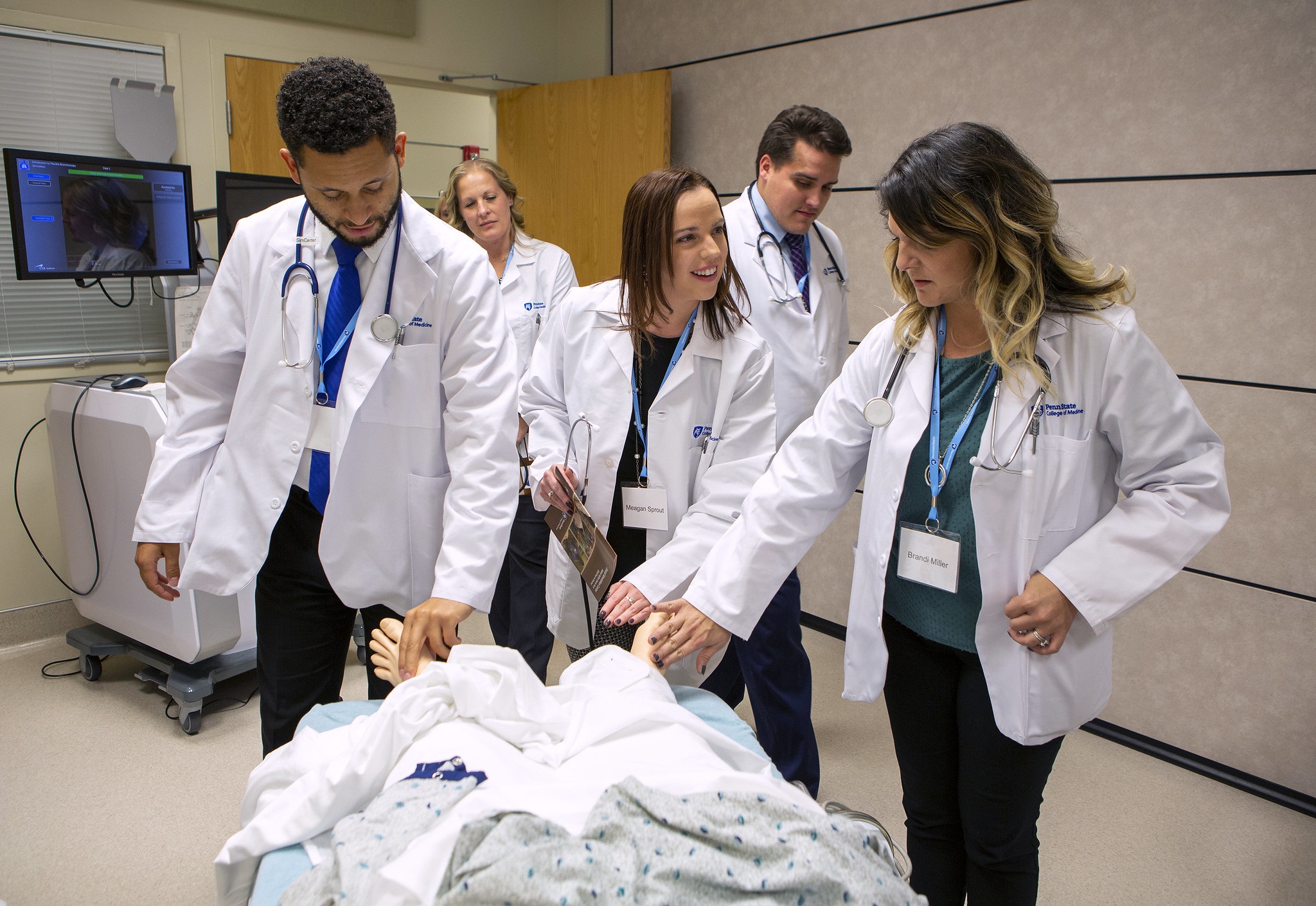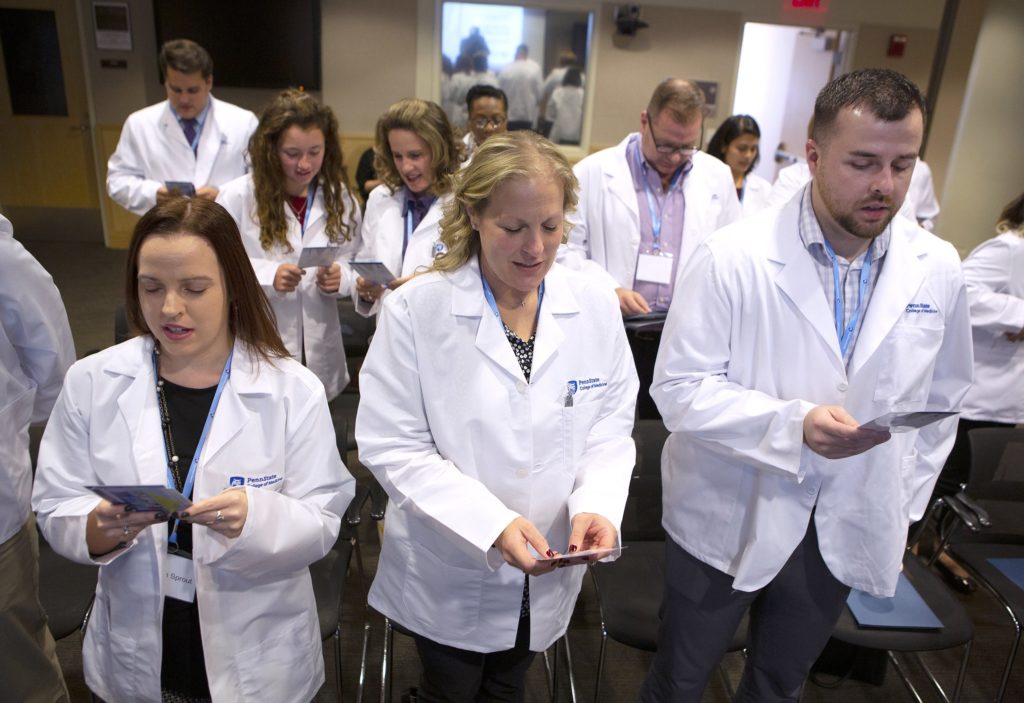Medical student for a day: Project Medical Education gives lawmakers insight into costs vs. rewards of becoming a doctor

When Pa. State Rep. Sheryl Delozier, R-Cumberland County, put on her white coat during a ceremony at the beginning of the day, she noticed people looked at her differently than when she first walked into Penn State Health Milton S. Hershey Medical Center.
“People look at you with a sense of awe and respect when you have a white coat on,” Delozier said. “It also gave me a great sense of pride. I can only imagine the amount of anticipation a medical student feels when they start their education.”
Once her white coat was on, she didn’t have to imagine any longer. She and 15 other people had the opportunity to sample medical education through a variety of lectures and activities throughout the day.

See full photo gallery on Flickr
Four years of curriculum, one day of learning
It may seem challenging to cram four years of medical education into one day, but faculty and staff at Penn State College of Medicine gave it their best shot.
They invited a group of Pennsylvania lawmakers, legislative staffers and other government employees to experience firsthand what life as a medical student is like during the College of Medicine’s Project Medical Education program on Nov. 1.
The event was developed by the Association of American Medical Colleges to help medical schools and teaching hospitals educate members of Congress and their staff about the process of medical education, its benefits, its complex funding mechanisms and the essential role of the government in providing financial support.
Simulations within the simulation
The group quickly found out that it takes a lot of tools and resources to train future physicians. After a welcome from College of Medicine interim dean, Dr. Kevin Black, and a lesson on health systems science from Dr. Terry Wolpaw, vice dean for educational affairs, and Dr. Dwight Davis, associate dean for medical student admissions, the participants headed to a laboratory. There, faculty members taught them about the tools they use to teach future doctors the skills they need to diagnose and treat patients.
After watching a demonstration of ultrasound technology and learning about the anatomy of the arm through a virtual cadaver, Delozier gained an appreciation for the challenges facing medical students.
“Virtual reality gave us the ability to study the complex details of different parts of the arm from a variety of angles,” Delozier said. “There’s a lot for medical students to learn, and these tools are essential to their success.”
The participants also spent time at the College of Medicine’s Clinical Simulation Center. Franklin Banfer, one of the center’s program managers, coached a session on cardiopulmonary resuscitation, or CPR.
“It’s a skill everyone needs, and simulation provides a safe and effective space for people to learn,” Banfer said. “Giving good CPR is difficult, and the technology in our mannequins allows learners to get feedback in real time.”
Practicing compassion… and medicine
What surprised Delozier most was learning that there are two sides to being a doctor. A humanities lecture delivered by Bernice Hausman, chair of the Department of Humanities, and Dr. Martha Levine, associate professor of pediatrics, psychiatry and humanities, helped the participants understand that doctors should be as competent in communicating with patients as they are in their medical knowledge.
“People may not realize that there are methods for teaching empathetic bedside manner,” Delozier said. “During the humanities lecture, we learned the importance of understanding who the patient is before you treat them.”
The participants got to put their humanistic, bedside manner to the test through another exercise at the Simulation Center. They watched from another room while a volunteer from the group took a patient’s medical history.
It wasn’t a real patient but rather one of the College of Medicine’s standardized patients. These actors and actresses portray a variety of personalities and symptoms and are a crucial part of helping future physicians learn to communicate with patients.
Investment with priceless return
At the end of the six-hour day, Project Medical Education participants received their medical degrees during a graduation ceremony ― along with a bill for their education. According to the Association of American Medical Colleges, the median four-year cost of attendance for medical school for the class of 2020 is $255,517 for public schools and $337,584 for private schools.
Ultimately, Delozier said she values opportunities to see how tax dollars – including those allocated to medical schools – are spent.
“It’s important to remember events like Project Medical Education when budget items are discussed in the legislature,” Delozier said. “Experiencing firsthand the hard work these students put in to take care of us and understanding the cost of their education is invaluable.”

From left, front, Meagan Sprout, Janelle Lynch and Marc Pugliese recite the medical student oath during a white coat ceremony at Project Medical Education.
If you're having trouble accessing this content, or would like it in another format, please email Penn State Health Marketing & Communications.
